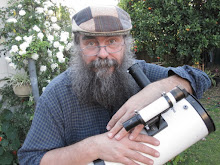Tuesday, February 25, 2025
Thursday February 27 to Thursday March 6
The New Moon is Friday February 28. Venus is becoming harder to see low in the twilight, and is close to the thin crescent Moon on the 2nd. Jupiter and Mars are visible in the evening sky. Jupiter is past opposition and is visible all evening long. The Moon is close to Jupiter on the 6th. Mars is high in the early evening sky.
The New Moon is Friday February 28. The moon is at apogee, when it is furthest from the Earth, on the 2nd of March.
Venus is visible in the early twilight. You will need a clear, level horizon to see Venus. Venus is a thin crescent in telescopes.
The inset is the telescopic view of Venus at this time.
Similar views will be seen from the rest of Australia at roughly the equivalent local time (90 minutes after sunset).
Similar views will be seen from the rest of Australia at roughly the equivalent local time (90 minutes after sunset).
Elsewhere in Australia will see a similar view at the equivalent time (90 minutes after sunset).
Mercury is lost in the evening twilight.
Venus is lowering in the evening twilight and is becoming more difficult to see.
Mars is high in the evening sky. Mars was at opposition, when it is biggest and brightest as seen from Earth, on January the 16th.
Jupiter is high in the the north-western evening sky when the sky is fully dark.
Saturn is lost in the twilight.
Star Map via Virtual sky. Use your mouse to scroll around and press 8 when your pointer is in the map to set to the current time.
Cloud cover predictions can be found at SkippySky.
Here is the near-real time satellite view of the clouds (day and night) http://satview.bom.gov.au/
Labels: weekly sky
Monday, February 17, 2025
Thursday February 20 to Thursday February 27
The Last Quarter Moon is Friday February 21. Venus, Jupiter and Mars are visible all together (briefly) in the evening sky. Jupiter is past opposition and is visible all evening long. Mars is rising in the early evening sky, and is visible all night long. Mercury and Saturn are lost in the twilight.
The Last Quarter Moon is Friday February 21.
Venus is readily visible from early twilight to just after nautical twilight. You will need a clear, level horizon to see Venus. Venus is a thin crescent in telescopes.
Saturn is lost in the twilight.
The inset is the telescopic view of Venus at this time.
Similar views will be seen from the rest of Australia at roughly the equivalent local time (90 minutes after sunset).
Similar views will be seen from the rest of Australia at roughly the equivalent local time (90 minutes after sunset).
Elsewhere in Australia will see a similar view at the equivalent time (90 minutes after sunset).
Mercury is lost in the evening twilight.
Venus is lowering in the evening twilight and is readily visible in the late twilight.
Mars is rising in the evening sky. Mars was at opposition, when it is biggest and brightest as seen from Earth, on January the 16th and is visible all night long.
Jupiter is high in the the north-western evening sky when the sky is fully dark.
Saturn is lost in the twilight.
Star Map via Virtual sky. Use your mouse to scroll around and press 8 when your pointer is in the map to set to the current time.
Cloud cover predictions can be found at SkippySky.
Here is the near-real time satellite view of the clouds (day and night) http://satview.bom.gov.au/
Labels: weekly sky
Monday, February 10, 2025
Thursday February 13 to Thursday February 20
The Last Quarter Moon is Friday February 21. Saturn, Venus, Jupiter and Mars are visible all together (briefly) in the evening sky. Venus is at it greatest brilliance on the 15th. Jupiter is past opposition and is visible all evening long. Mars is rising in the early evening sky, and is visible all night long. Mercury is lost in the twilight.
The Full Moon is Wednesday February 12. The Last Quarter Moon is Friday February 21. The Moon is at apogee, when it is furthest from the Earth, on Tuesday the 18th.
Venus is readily visible from early twilight to just before the sky is fully dark. You will need a clear, level horizon to see Venus. Venus is at its greatest brilliance and is a thin crescent in telescopes.
Saturn is only briefly visible before it disappears into the horizon murk.
The insets are the telescopic views of Venus at this time.
Similar views will be seen from the rest of Australia at roughly the equivalent local time (90 minutes after sunset).
Similar views will be seen from the rest of Australia at roughly the equivalent local time (90 minutes after sunset).
Elsewhere in Australia will see a similar view at the equivalent time (90 minutes after sunset).
Mercury is lost in the evening twilight.
Venus is lowering in the evening twilight and is readily visible in the late twilight.
Mars is rising in the evening sky. Mars was at opposition, when it is biggest and brightest as seen from Earth, on January the 16th and is visible all night long.
Jupiter is high in the the evening sky when the sky is fully dark.
Saturn is lowering in the evening sky. Saturn is soon lost in the twilight.
Star Map via Virtual sky. Use your mouse to scroll around and press 8 when your pointer is in the map to set to the current time.
Cloud cover predictions can be found at SkippySky.
Here is the near-real time satellite view of the clouds (day and night) http://satview.bom.gov.au/
Labels: weekly sky
Tuesday, February 04, 2025
Thursday February 6 to Thursday February 13
The Full Moon is Wednesday February 12. Saturn, Venus, Jupiter and Mars are visible all together (briefly) in the evening sky and lined up with the Moon. The Moon is near Jupiter on the 6th and 7th, then Mars on the 9th and 10th. Jupiter is past opposition and is visible all evening long. Mars is rising in the evening sky, and is visible all night long. Mercury is lost in the twilight. Fading Comet C/2024 G3 (ATLAS) is still visible in binoculars.
The Full Moon is Wednesday February 12.
Venus is readily visible from early twilight to when the sky is fully dark, although its sets shortly after. You will need a clear, level horizon to see Venus when the sky becomes fully dark. Venus is drawing away to Saturn, which is becoming harder to see in the horizon murk.
The insets are the telescopic views of Venus and Saturn at this time.
Comet C/2024 G3 (ATLAS) is visible in binoculars in the evening twilight above Saturn and Venus. While the nucleus has disintegrated the tail is still visible but a shadow of its former self. For more details and spotter charts see my Comet C/2025 G3 page.
Similar views will be seen from the rest of Australia at roughly the equivalent local time (90 minutes after sunset).
Similar views will be seen from the rest of Australia at roughly the equivalent local time (90 minutes after sunset).
Elsewhere in Australia will see a similar view at the equivalent time (90 minutes after sunset).
Mercury is lost in the morning twilight.
Venus is lowering in the evening twilight and is readily visible. In the evening Venus is drawing away from Saturn.
Mars is rising in the evening sky. Mars was at opposition, when it is biggest and brightest as seen from Earth, on January the 16th and is visible all night long. The Moon is near Mars on the 9th and 10th.
Jupiter is high in the the evening sky when the sky is fully dark. It is close near the waxing moon on the 6th and 7th.
Saturn is lowering in the evening sky drawing away from Venus.Saturn is soon lost in the twilight.
Star Map via Virtual sky. Use your mouse to scroll around and press 8 when your pointer is in the map to set to the current time.
Cloud cover predictions can be found at SkippySky.
Here is the near-real time satellite view of the clouds (day and night) http://satview.bom.gov.au/
Labels: weekly sky
Monday, February 03, 2025
Seeing the Lunar X, Wednesday, February 5, 2025
| The Lunar X and V (indicated) as visible in telescopic views. Click to embiggen for a clearer view. | Western evening sky on Wednesday February 5 as seen from Adelaide at 21:43 ACDST | Western evening sky on Wednesday February 5 as seen from Brisbane at 20:19 AEST |
The Lunar X (also known as the Werner X) and the Lunar V will be visible this Wednesday as the moon reaches Firt Quarter.
The Lunar X is a chiaroscuro effect in which strong contrasts of light and shadow create the appearance of a letter 'X' on the rim of the Lunar craters Blanchinus, La Caille and Purbach and a letter V from the rim of the crater Ukert, along with several smaller craters.
The X and V are seen at first quarter, visible on the lunar surface for about 4 hours. However, the Moon is not always above the horizon from a given vantage point when this happens. This month is good for Australian observers
Lunar X occurs on Wednesday February 5, 08:13 UT, 21:13 AEDST, 20:13 AEST, 20:43 ACDST, 19:43 ACST, 16:13 AWST). This is later than official first Quarter which occurs at 18:32 ACDST.
This is a telescope (and maybe good binoculars) only event. For the west coast the start of the Lunar X occurs when the sun is up, but the X is still visible 3 hours later in the deep twilight, with the Moon being 34° above the horizon, central states see it at 22° above the horizon, and for the east coast at 20° above the horizon.
Upcoming Lunar X' s are shown below:
Dates and time Lunar X and V are visible. Typically visible from about 4hours from the starting time, times in colour are daylight saving times.
| Date | UT | AEST | ACST | AWST |
| Feb 5 | 08:13 | 21:13 | 20:43 | 16:13 |
| Apr 5 | 12:43 | 23:43 | 23:17 | 20:43 |
| June 3 | 13:18 | 23:18 | 22:30 | 21:18 |
| Aug 1 | 10:57 | 20:57 | 20:17 | 18:57 |
| Sep 29 | 08:46 | 18:46 | 18:16 | 16:46 |
| Nov 27 | 10:43 | 21:43 | 21:15 | 18:43 |
Labels: Lunar X, Moon, telescope





















 Click to read about or order
Click to read about or order Click to read about or order
Click to read about or order Click to read about or order
Click to read about or order Click to read about or order
Click to read about or order




